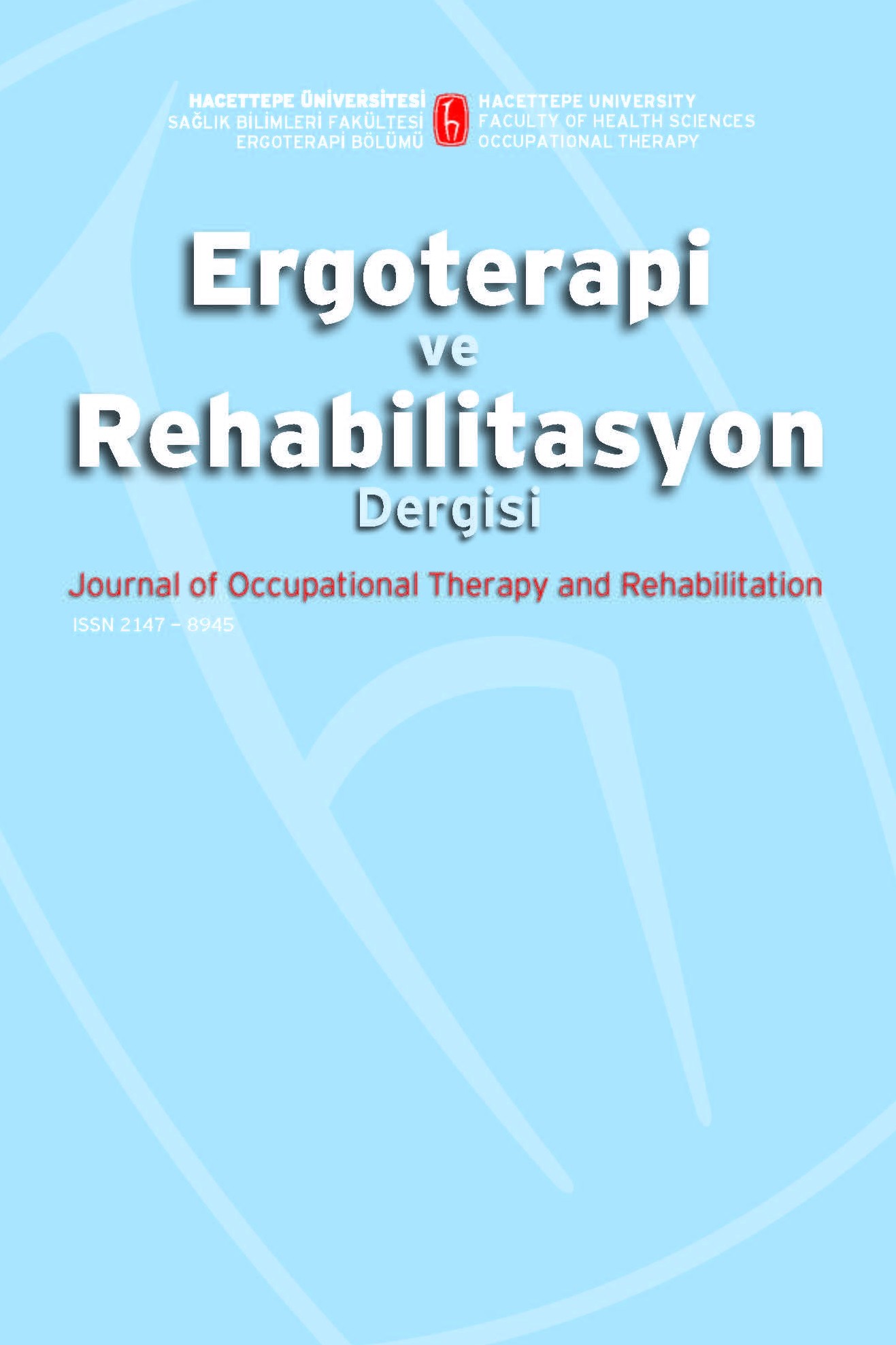Şizofreni Tanılı Bireylerde Dikkat Eğitiminin Dikkat Seviyesi ve Yardımcı Günlük Yaşam Aktivitelerine Etkisinin İncelenmesi
Amaç: Şizofreni, kişinin düşünce süreçlerini, sosyal fonksiyonlarını, algı ve davranışlarını olumsuz etkileyen kronik bir hastalıktır. Bu çalışmanın amacı, dikkat eksikliği olan şizofreni tanılı bireylerde dikkat eğitiminin, dikkat seviyesi ve yardımcı günlük yaşam aktiviteleri (YGYA) üzerine etkisinin incelenmesidir. Gereç ve yöntem: Çalışmaya 4 şizofreni tanılı birey dahil edilmiştir. Katılımcılara 5 hafta boyunca haftada iki gün, günde 30 dakika süren dikkat eğitimi verilmiştir. d2 dikkat testi ve Lawton-Brody Yardımcı Günlük Yaşam Aktiviteleri İndeksi eğitim öncesi ve 5 haftalık eğitim sonrası olmak üzere iki kez uygulanarak müdahalenin sonuçları değerlendirilmiştir. Sonuçlar: Çalışmanın sonucunda katılımcıların dikkat testi sonuçlarında değişimler görülmesine rağmen dikkat seviyeleri ve YGYA becerilerinde istatistiksel olarak fark bulunmamıştır. Tartışma: Şizofreni tanısı almış bireylere yönelik müdahaleler planlanırken, bağımsız yaşam ve işlevsellik ile doğrudan ilişkili olan dikkat bozuklukları göz önünde bulundurulmalıdır. En uygun müdahaleleri ve onların uzun dönem etkilerini belirlemek için, geniş örneklem gruplarıyla daha ileri kontrollü çalışmalara ihtiyaç vardır.
Investigation of The Effect of Attention Training on Attention Level and Instrumental Activities of Daily Living in People with Schizophrenia
Purpose: Schizophrenia is a chronic disease that negatively affects person's thought processes, social functions, perception and behaviours. The aim of this study is to investigate the effect of attention training on attention level and instrumental daily living activities (IADL) in people diagnosed with Schizophrenia. Materials and Method: Four individuals with Schizophrenia were included in the study. 30 minutes of attention training sessions twice a week for five weeks were provided to the participants. The outcomes of the intervention were assessed by d2 Test of Attention and Lawton-Brody Instrumental Activities of Daily Living Scale before and after the attention training. Results: At the end of the study, results of the participants' attention tests changed positively. However, there was no statistically significant difference in attention levels and IADL abilities between pre and post-intervention. conclusion: When planning interventions for people diagnosed with schizophrenia, consideration should be given to attention deficits that are directly related to independent living and functioning. Further controlled studies with larger samples are needed to determine optimal interventions and their long-term effectiveness.
___
- Aksaray, G., Oflu, S., & Kaptano, C. (2001). Şizofrenide bilişsel işlevlerde bozulma. Düşünen Adam, 14(4), 205- 210.
- Ashwini, D., Recani T. G., & Chauhan, A. (2016). Effectiveness of Cognitive retraining in chronic mental illness. The International Journal of Indian Psychology, 3(3), 42-53.
- Bozan, A., & Yasin, A. (2012). The Effect of attention improvement training on the primary school 5th grade students'skills of gathering attention. Batı Anadolu Eğitim Bilimleri Dergisi, 3(6), 53-66.
- Brenner, H. D., Roder, V., Hodel, B., Kienzle, N., Reed, D., & Liberman, R. P. (1994). Integrated psychological therapy for schizophrenic patients (IPT): Hogrefe & Huber Publishers.
- Brickenkamp, R. & Zillmer, E. (1998). The d2 Test of Attention. Seattle, Washington: Hogrefe & Huber Publishers.
- Cormac, I., Jones, C. & Campbell, C. (2002). Cognitive behaviour therapy for schizophrenia (Cochrane Review). The Cochrane Library, 1. Update Software: Oxford.
- Çağlar, E., & Koruç, Z. (2006). D2 dikkat testinin sporcularda güvenirliği ve geçerliği. Journal of Sport Sciences, 17 (2), 58-80.
- Evans, J. D., Heaton, R. K., Paulsen, J. S., Palmer, B. W., Patterson, T., & Jeste, D. V. (2003). The relationship of neuropsychological abilities to specific domains of functional capacity in older schizophrenia patients. Biol Psychiatry, 53(5), 422-430.
- Gold, J. M., & Harvey, P. D. (1993). Cognitive deficits in schizophrenia. Psychiatr Clin North Am, 16, 295-312.
- Goldberg, J. (1994). Cognitive retraining in a community psychiatric rehabilitation program. In W. Spaulding (Ed.), Cognitive technology in psychiatric rehabilitation (p. 67-86). Lincoln, NE: University of Nebraska Press.
- Green, M. F., Kern, R. S., Braff, D. L., & Mintz, J. (2000). Neurocognitive deficits and functional outcome in schizophrenia. Schizophr Bull, 26(1), 119-136.
- Hadas-Lidor, N., Katz, N., Tyano, S., & Weizman, A. (2001). Effectiveness of dynamic cognitive intervention in rehabilitation of clients with schizophrenia. Clin Rehabil, 15(4), 349-359.
- Hegde, S., Rao, S. L., Raguram, A., & Gangadhar, B. N. (2012). Addition of home-based cognitive retraining to treatment as usual in first episode schizophrenia patients: A randomized controlled study. Indian journal of psychiatry, 54(1), 15-22.
- Hermanutz, M., & Gestrich, J. (1991). Computer-assisted attention training in schizophrenics. Eur Arch Psychiatry Clin Neurosci, 240(4-5), 282-287.
- Lawton, M.P., & Brody, E.H. (1988). Instrumental activities of daily living (IADL) scale: original observer-rated version. Psychopharmacol Bull, 24, 785-91.
- Lipskaya, L., Jarus, T., & Kotler, M. (2011). Influence of cognition and symptoms of schizophrenia on IADL performance. Scand J Occup Ther, 18(3), 180-187.
- Medalia, A., Aluma, M., Tryon, W., & Merriam, A.E. (1998). Effectiveness of attention training in schizophrenia. Schizophr Bull, 24(1), 147-152.
- Yardımcı, E. (1995). İstanbul'da yaşayan yaşlı öğretmenlerin sağlık sorunlarının günlük yaşam aktiviteleri ve aletli günlük yaşam aktiviteleri ile ilişkisi. İstanbul Ü. Tıp Fakültesi Halk Sağlığı ABD, Uzmanlık Tezi, İstanbul.
- Yaycı, L. (2013). d2 dikkat testinin geçerlik ve güvenirlik çalışması. Kalem Eğitim ve İnsan Bilimleri Dergisi, 3(1), 43-80.
- ISSN: 2147-8945
- Yayın Aralığı: Yılda 3 Sayı
- Başlangıç: 2013
- Yayıncı: Hacettepe Üniversitesi Sağlık Bilimleri Fakültesi
Sayıdaki Diğer Makaleler
Esra AKI, Banu ARSLANTEKİN ALTUNAY
Tuba TUNCER, Banu ARSLANTEKİN ALTUNAY
Wistar Sıçanlarda Erken Dönem Deneyimlerinin Duyusal Motor Yanıtlar Üzerine Etkileri
Hatice ABAOĞLU, Esra AKI, Akfer KARAOĞLAN, Gamze EKİCİ, Huriye Gökçe ŞAHİN
Isı Hassasiyeti Olan Multipl Skleroz Hastalarında Egzersiz Önerileri: Anlatımsal Bir Derleme
